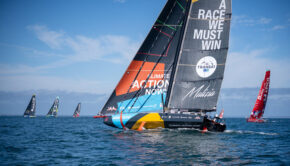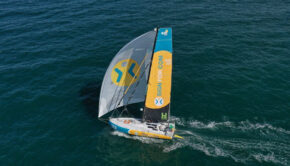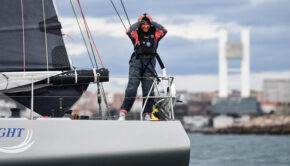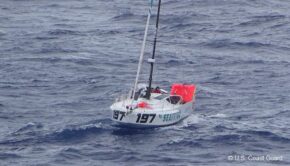Season of Postponements
Published on November 3rd, 2013
The 5460 mile Transat Jacques Vabre race celebrates its eleventh edition, taking the 44 doublehanded entrants in four different classes (Class40, Open 60, Multi50, and MOD 70) from Le Havre, France to Itajai, Brazil. However, severe weather has interrupted the schedule of this biennial classic, which was to originally start on Sunday, November 3.
Current forecasts indicate a Thursday start to be considered a possibility. “Winds 30 to 50 knots which could endanger the skippers and their boats are forecast,” explained Sporting Director Manfred Ramspacher. “We are well aware that classes such as Open 60 could start. But our main concern is the overall safety of the crews. Our first aim is to ensure we can get maximum number of boats finishing Itajai.”
Reviewing the current race is American Joe Harris, who won his division in 2005 on an Open 50 all-carbon offshore racing machine with Josh Hall….
“As I think back and compare the racing fleets of 2005 versus the boats in the 2013 race, a few major differences are apparent.
“First, the class of boat that I was sailing, the Open 50, while great boats and I think a perfect size for offshore short-handed sailing, have gone away in favor of the larger Open 60s and the smaller, less expensive Class 40s. The cost saving measures employed in Class 40 has found a popular market niche that combines high performance with reasonable cost and a relatively tight Box rule that allows older boats to remain competitive against the latest generation.
“Interestingly, the Open 60s, which are more akin to Formula One race cars, struggled during the recessionary years but have remained fairly stable as a fleet – 10 in the 2005 fleet and 12 in the 2013 fleet. The big ORMA 60 trimarans went away but were recently replaced by the MOD 70 tri’s, which were thought to be more seaworthy until two recent capsizes. The Multi50s have hung on and fleet size has remained about 7 boats.
“As I look at the fleet of 26 Class 40 boats and 52 sailors, there are many familiar boats and skippers. Most of the fleet are newer boats and a handful are brand new, and these boats generally have a bit of an edge on the older boats while power reaching in surfing conditions as the hull shapes have become broader and more powerful, but that hull shape does not necessarily have an advantage over the narrower Gen One boats while sailing upwind or tight reaching.
“Hopefully the fleet can escape the English Channel and Bay of Biscay at the start without getting completely hammered by gales as we did in 2005! We experienced headwinds over 40 knots and towering breaking seas that put many boats – particularly the multihulls – out of the race early.”









 We’ll keep your information safe.
We’ll keep your information safe.